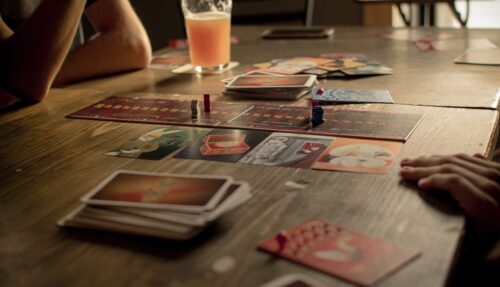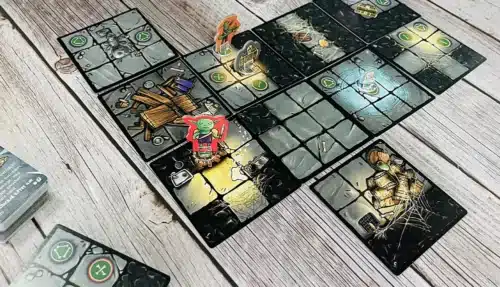For your board game design to be successful, you'll need to write an exceptional rule book. Here, we explain step-by-step how to do just that!

Designing a board game is an exciting and rewarding endeavor, but one of the most challenging aspects for any game designer is crafting a clear and concise rulebook. The rulebook is not just a set of instructions; it is an essential component that guides players through the game’s mechanics, supporting a balanced and enjoyable experience. Writing an effective rulebook requires more than just relaying information—it demands the creation of guidelines that are both easily understandable and engaging for the reader.
In this post, we’ll explore the key elements and strategies you need for writing a successful rulebook. This involves not only the principles of clear and accessible rule writing, but also the comprehensive process of developing the rulebook itself. The goal is to articulate your intentions with precision while empowering players to fully grasp the game, all within a format that communicates necessary details without becoming overly formal or dense. A well-crafted rulebook is essential for guiding players through your game, making it an integral part of the design process.
At QinPrinting, we offer a comprehensive board game manufacturing service, including rule book printing. We have been in the business for nearly 30 years now and our reputation is built on our expert knowledge and experience combined with state-of-the-art technology and world-class customer service. By the time you’ve read this post, you’ll have a solid understanding of everything you need to know regarding how to write a board game rule book. If you’re keen to find out more about our services first, check out Custom Board Game Services. Still here and keen to learn everything there is to know about preparing a first class rule book for your game? Cool, let’s get the dice rolling!
Who is the rule book for?
So, this might seem like a no-brainer of a question, but it’s actually more complicated than you might think! Yes, you’re right that the rule book is for people who want to play your game. However, those potential players may have distinct and diverse needs when it comes to what they want from your rule book in any given situation.
Think about the brand new player, fresh from the experience of unboxing your board game, and setting out the components for the first time ready to play. They depend on the rule book as their main guide for learning the game, making clarity and ease of understanding essential. And even if your game is reasonably complex, they’re excited to get started and don’t want to spend several hours trying to figure out how to play.
Now what about players who have familiarized themselves with the rules and maybe played a few times? In many games, there’s often something new to discover or a novel situation arises that needs resolution without a gross interruption of the flow of play. These players, actively engaged in the game, use the rulebook as a reference tool to resolve questions or navigate unfamiliar situations, necessitating quick access to clear answers so they can learn and get back into the game as soon as possible.
Someone who has played the game before but let it sit on the back burner for a while needs only a concise memory-jogging refresher on the key rules, requiring the rule book to provide succinct reminders of the essential mechanics and tactics. Those facts and figures must be easy and intuitive to find to avoid such a player feeling lost and frustrated.
We’re sure you’ll understand that designing a rule book that caters to all these varied players is essential to providing a smooth and enjoyable play experience for everyone involved. The structure, layout, and indexing of the rule book play a critical role in achieving this—and we’ll cover this in detail in this post—as they determine how easily players can find and understand the information they need. A well-organized rule book with a logical flow and intuitive design improves is easy to use and cuts out confusion. It also avoids players wasting a ton of time searching for specific details which should be ready to hand. Effective indexing in longer or more complex rule books guarantees that all types of players can quickly locate the sections relevant to their immediate needs, making the rule book a more efficient and user-friendly tool.
In the rest of this post, we’ll look at how you can compose the perfect rule book that caters to the needs of all possible players; no matter what their level of experience or the moment at which they’re interacting with the game when the need for the rule book arises. This is primarily to do with the structure and layout. So, that’s what we’ll look at next.
Understanding the principles of structure
Before diving into the textual/content details of rule book writing, it’s important to understand the general structure that most rule books follow and why. While there is no one-size-fits-all approach, a well-structured rule book typically includes the following sections:
1. Introduction and theme
Start your rule book – after you’ve written a concise introduction to who you (or your game company) are with an engaging introduction that sets the scene and captures the sense and atmosphere of your game’s theme. This section should summarize the game’s setting and storyline, creating anticipation and excitement for players. It’s all about context, atmosphere, and stating the challenge the players will enjoy. Try to state in a succinct but evocative way, the five Ws. Don’t know what they are?
- Who: what kind of characters or roles are the players going to be in your game? Business people, knights, detectives, animals, avatars? Whatever the answer, make it crystal clear at the outset.
- What: make sure you state the exact task or aim that the characters are trying to achieve in the game. For example, amass as much treasure as they can, get to a destination first, eliminate other players or a non-player character, occupy most territory, etc.
- Where: this is the game equivalent of “world-building” in a novel. So, what kind of world and setting does your game propose? Urban or rural? Fantasy or science fiction? In a single location or across several? Is it on a local, national, global, stellar or intergalactic scale?
- When: So, this is about the time period. Is it contemporary or historical? If it’s historical, which period? For example, is it prehistoric like Stone Age or Taluva; medieval-like The Castles of Burgundy or A Feast for Odin; the 19th century like Age of Steam, Imperial, or Tinner’s Trail? Or maybe it’s neither contemporary or historical but futuristic like Twilight Imperium, Terraforming Mars, or Scythe.
- Why: in board game terms, this is about what the players need to do to win. Right up from, let them know how they’ll know when the game has ended and who the winner or winners are. That’s the “why” of all games, after all, even cooperative versions.
If your game were a novel, this would be the publisher’s blurb on the back cover, designed to let you know what the book’s about while exciting you to read. But it isn’t a novel, so the key is to express all of this information in as clear and concise a manner as possible. Hey, we never promised this would be easy!
2. Objectives and goals
The primary function of any rule book is to explain the goals and objectives of the game clearly in relation to the theme. Players should have an unequivocal understanding of what they need to achieve and how they will interact with each other during gameplay. This section sets the foundation for the gameplay and helps players grasp the overall purpose of the game so they have a good foundation as they dive into the complexities of decision-making.
3. Components and Setup
List and describe the game components, making sure that players can identify and set up the elements with ease. Often, in this section, you’ll want to include illustrations and diagrams. Make instructions on how to arrange the components and any preparatory steps required before starting the game as simple as possible. Including color-coding, bullet points, flowcharts, and images can enhance the clarity of this section. Here are our top tips for getting the setup section right.
- Use photos, screenshots, graphics, and annotated diagrams. Show players exactly how the game should look when it’s all set up. At a push, you could use a game simulator but the best options are usually photos of a real game or professionally designed graphic representations. Add labels or numbers to the different game parts (like card decks, meeples, containers, tiles, board modules and other components) using a simple system of say, numbers and a key, to show what the parts are and where everything goes.
- Explain the steps clearly. Write out the steps to set up the game in the right order, like separating cards, shuffling decks, and placing things in specific spots. Use the pictures to help explain these steps.
- Make information easy to see. Tell players clearly if something should be face-up or face-down, and if it should be public or hidden. Don’t make players guess what should be shown or kept secret. If something is unusual or tricky (like holding cards in a special way), make it stand out with bold text, italics, or color.
- Decide who starts the game. Add a simple rule for picking the starting player after setting up the game. You can use a traditional rule like the highest or lowest roll of a die or pick a card at random or invent something innovative of your own, perhaps related to the game’s theme or setting.
Once you’ve completed the basic introduction, described the components and given a detailed and logical explanation of the setup, the next thing to do is teach the players how to play the game! Essentially, this is where you introduce the mechanics. But remember, while you as a game designer know what “mechanics” means in game design jargon, most players don’t and don’t need to, either. So, rather than giving a technical description and explanation of each mechanic, start by showing direct examples of play based on what players can and can’t do, and why, in each turn. That’s what we’ll look at now.
4. Gameplay mechanics
This section describes and explains the core mechanics of the game, showing how the game progresses and what actions players can take on their turns. It’s vital to provide a detailed and step-by-step breakdown of a typical turn, including any special actions. Use examples and illustrations to explain complex concepts and help players grasp the mechanics effectively.
Start by giving a brief overview of the actions players can choose from on their turn. For example, you could say, “Players can choose between moving, buying, selling, or picking a card on each turn.” After this summary, provide a more detailed description of each action, its potential pros and cons in a range of typical situations, and its effects and possible outcomes.
Make sure to describe a typical turn in a clear, step-by-step manner, including any special moves or actions. To help players understand the rules, we strongly recommend that you include examples and images. You can place these examples in side sections to keep the main instructions easy to follow.
When putting the rule book together, focus on presenting the information in a logical order. It can be helpful to have someone else review the rules to guarantee everything flows well. Avoid requiring players to jump around back-and-forth to different sections of the rule book. Present the information they need in the order they’ll need it. Avoid repeating information unnecessarily, too. If something is important, you can emphasize it with bold, colored, or italic text instead of repeating it.
A word about writing style. Make sure you write the text with confidence and a sense of authority. You reinvented the game, and the players need to feel instant confidence and trust in your explanations; remember that even if you write with personal flair, this is essentially technical writing, and writing with an authoritative style also helps with clarity and precision. So, use clear and straightforward language, avoiding humor (because everyone’s sense of humor is different, and this isn’t the place for it anyway). Also avoid fancy language or overly decorative phrases that might confuse readers. If your game includes humorous elements, that’s fine, but don’t let them confuse the clarity of your explanations.
The core takeaway here is that all the mechanics of the game should be explained with reference to examples of player actions and choices during a turn.
A top tip for you: during your playtesting phase, ask the winning player how they would teach the game to someone else. Their perspective can help you identify any areas where the rules might need to be clarified and show you where things are already working well.
5. Endgame and scoring
When explaining how your game ends, it’s a good idea to have two parts: one for how each round ends and another for how the whole game finishes. You don’t always need both, but it can be helpful to show players what to do at the end of each round or when to check if the game is over. This is one of the few times it’s okay to tell players to look at another part of the rule book!
It’s very important to explain clearly how the game ends and when the players should stop. For example, you could write, “The game ends after each player has had 10 turns,” or “The game is over when one of the players reaches their home base.” In many games, there’s something players need to do after the game-ending event but before the game officially ends completely, so make sure to tell them. For example, you might write, “Finish the current turn so everyone gets the same number of chances.”
Next, because “game ends” and “winner is” can be two different factors – say, if the game ends when there are no more cards in the pile but we still don’t know who has captured the most prisoners or whatever – you need to explain how to figure out who wins. If players earn points during the game, you can include the scoring rules when you explain each action. If scoring happens at the end of each round, put those details in that part of the rules.
If most of the scoring happens when the game is over, make sure to explain that clearly. If your game uses a scoring board, you could show a picture of it. If the scoring is tricky – such as “add ‘x’ points for this, subtract ‘x’ points for that, double your score if…” etc. – give simple examples to help players understand.
When you’re writing the scoring rules, think about whether the points should be counted in a specific order. For games where players can score in different ways, this can be very helpful. Can each player count their own points, or should one player help by asking, “Who has the most apples?” Write down the steps in the order they should happen and use a numbered list to make it easy for players to follow. Sometimes you can combine scoring with cleaning up, too, as long as the pieces being scored won’t be needed again. For example, you could say, “After counting your apples, put them back in the basket.” If something needs to be saved for later, give a clear reminder: “After collecting a gem, keep it safe in your treasure chest.”
It’s really important to explain exactly what makes the game end and how to decide who wins. Tell players about any rules for scoring or breaking a tie if it’s needed. Make sure everyone knows how the game finishes and what they need to do to win. The rules for winning should be very clear, so no one gets confused.
6. Additional resources
It’s often a good idea to include an appendix or a glossary section — especially with more complex strategy games — where you can provide extra information that may not be necessary for gameplay but can enhance players’ understanding of the game. This can include detailed explanations of specific terms, breakdowns of card types, historical context or backstory, and frequently asked questions (FAQs) gathered during playtesting. If your game is super-simple, you may be able to index all the keywords yourself or even do without an index. But for most games, you’ll need to generate an index to go in the back of your rule book so that players can look up specific points quickly and easily. Indexing is quite complex and you may want to employ a professional indexer to handle this side of things for you.
Tips for writing clear and balanced rules
Once you’ve explored, arranged, and established the ideal structure for your rule book, you’ll need to tackle the actual writing process. Writing clear and balanced rules that effectively communicate the intricacies of your game may be harder than you think. But the key to success is in adopting the right approach and accepting that — like game design itself — writing a good board game rule book is an iterative process. So, get the first draft done, then come back to it to refine, edit, and rewrite as necessary. To get you started in the right direction, here are our top tips:
1. Playtest extensively
No amount of planning or theory can replace the importance of playtesting. Playtest your game repeatedly to make sure that the rules work as you intended and to identify any areas that may need clarification or change. Note players’ feedback and use it to refine your rule book.
2. Balance challenge and difficulty
You need to give serious thought to the level of challenge you want your game to have and make sure that your rules support that intended difficulty without making the game impossible to win. Strike a balance between providing enough constraints to create engaging gameplay and avoiding unnecessary complexity that may overwhelm or frustrate players.
3. Determine the luck-skill balance
Every game falls somewhere on the luck-skill spectrum. A die roll, for example, is always a luck move; but choosing when to roll the dice and how many or which dice to use could be a skill call. Decide where each element of your game lies along this spectrum and make sure that your rules create that balance. When writing your rules, communicate the role of luck and skill in the game, so that players understand the factors that contribute to success.
4. Avoid false choices
When presenting players with choices, make sure they are meaningful and have significant pros and cons. Avoid overwhelming players with a multitude of obvious decisions, as this can diminish the excitement and engagement of the game. Each choice should have a tangible impact on gameplay.
5. Highlight important keywords and concepts
When you’re writing your rules, it can really help to emphasize relevant keywords and concepts throughout the rule book. For example, capitalize keywords or phrases, use bold or italics to draw attention to them, and use specific terminology consistently to avoid confusion. This will help players grasp key concepts and rules more effectively and also help them find the information they need quickly and easily.
6. Be consistent
Consistency is vital in rule book writing. Use the same phrasing and capitalization when referring to specific elements, characters, components, or concepts throughout your rule book. This helps guarantee clarity and avoids confusion caused by inconsistent terminology.
7. Incorporate visual aids
During the process of writing, start to think about layout and how you’ll take advantage of visual aids, such as diagrams, illustrations, and icons, to reinforce the players’ understanding of complex concepts. Use images to clarify setup instructions, demonstrate gameplay examples, and illustrate the role of different components. Visual aids can significantly improve the overall readability and comprehension of the rule book.
8. Get external feedback
Involve others in the review process of your rule book. Ask friends, fellow designers, or professional editors to read and provide feedback on the clarity and effectiveness of your rules. External perspectives can help identify areas that may need further clarification or improvement. And if you’re designing a professional-level game to sell or for a Kickstarter campaign, then we recommend that once your rule book is as good as you can get it, you pay a professional editor and proof reader to read it and make any needed corrections before you print it.
The challenge of "quick-start" guides and reference materials
One of the biggest challenges you may encounter in rule book writing, as we mentioned at the start but is worth elaborating here now you have a deeper understanding of what’s involved, is catering to both new players and experienced players wanting either more detailed instructions or quick access to reference materials. Balancing the need for a quick-start guide and a comprehensive reference can be tricky.
Consider creating a separate quick-start guide that provides a streamlined introduction and walkthrough of the game for new players. This guide can focus on the essential rules and provide a step-by-step example of a representative session. By separating the quick-start guide from the comprehensive rule book, you can cater to the different needs of players at various stages of familiarity with the game.
When you’re writing the rule book, prioritize the presentation of information based on its relevance to players at different stages of gameplay. Clearly show which sections are essential for new players and which sections are more advanced or relevant to experienced players. Use formatting techniques, such as bolding or indenting, to highlight important sections and make it easier for players to skim through the rule book for specific information.
Writing a board game rule book
Writing an exceptional board game rule book requires careful planning, extensive playtesting, and effective communication. By following a well-structured framework, incorporating visual aids, and balancing the needs of new and experienced players, you can create a rule book that not only guides players through the mechanics of the game but also enhances their overall gaming experience, making the game more fun and memorable. Remember, a logical order, clarity of language and consistency in approach with plenty of relatable examples are the key takeaways. Coupled with continuous refinement based on player feedback, these principles will help you to write a board game rule book that is a valuable asset to your game and a great help to your players.
Talk to us! We're here to help
At QinPrinting, we offer a comprehensive board game printing and manufacturing service, including all components, rule books, and boxing. You can find out more here, and when you’re ready to print your rule book, we can offer you the best pricing, highest quality, and quickest turnaround-time on any type or style of custom game instructions. We guarantee the most professional service, and the highest quality product you can imagine. So, let’s talk. Shoot us an email to [email protected] or call us on +1 951 866 3971. We look forward to helping you create a fabulous board game rule book.










